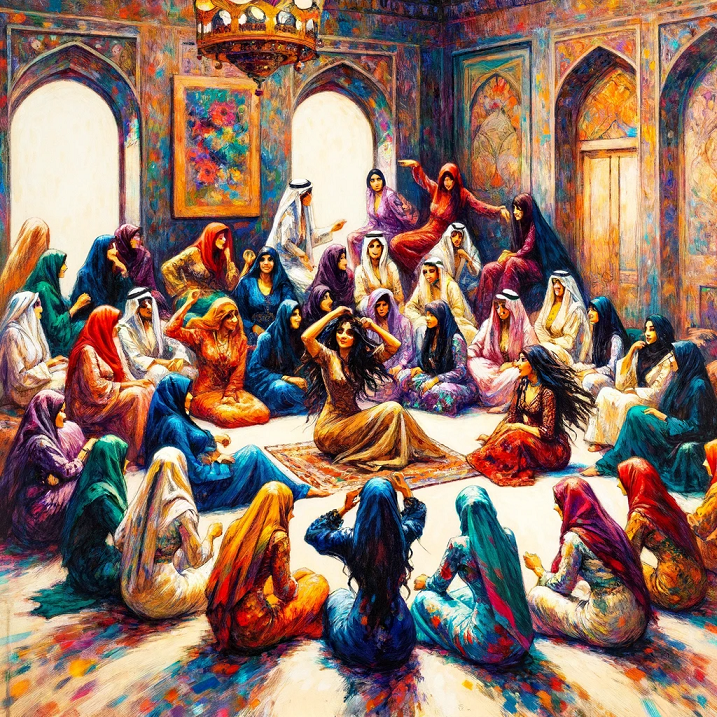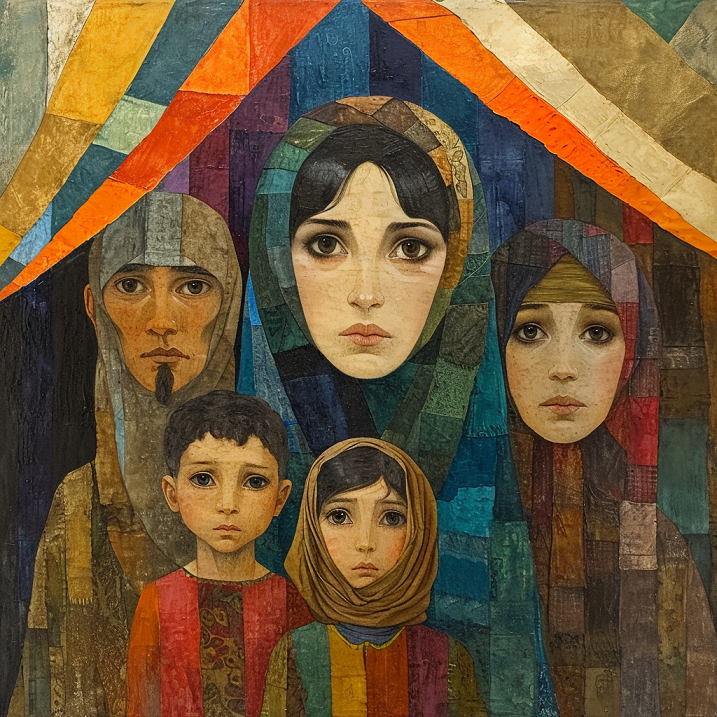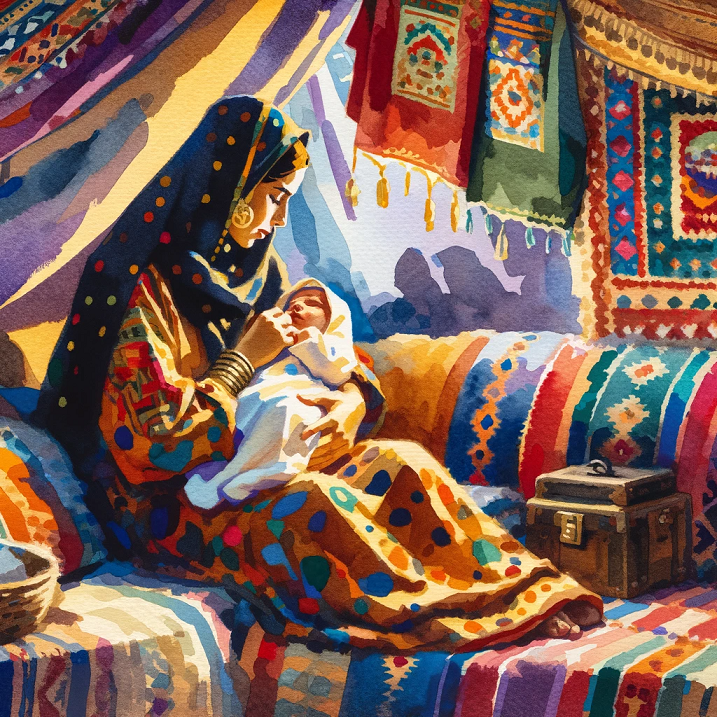In H.R.P. Dickson’s ethnographic account, “The Arab Of The Desert,” readers are offered a captivating glimpse into the lives of Bedouin Arabs in and around Kuwait during the early 20th century. This work delves deep into the cultural intricacies, customs, and traditions that defined the existence of the Bedouin communities in this region.
Key Takeaways:
- Children hold paramount importance in Bedouin Arab culture, with motherhood revered and childlessness viewed as a potential cause for divorce.
- Ethical dilemmas surround male circumcision, highlighting the need for medical care and the evolving perspective within some communities.
- Female circumcision exhibits regional variation, with some communities practicing it discreetly, raising questions about cultural relativism.
- Protective rituals against the Evil Eye reflect the deep-seated belief in unseen forces and the meticulous nature of Bedouin Arab customs.
- Linguistic nuances in terminology underscore the cultural significance of pregnancy and birth, emphasizing the Bedouin Arabs’ attention to detail.
Among these themes covered by Dickson, motherhood and childbirth occupy a significant position. For Bedouin women, the aspiration to have children is not merely a personal desire but a fundamental aspect of their cultural upbringing. This desire is ingrained in them from childhood, reinforced by societal expectations, and underscored by the reproach attached to childlessness. Moreover, the consequences of not producing a son and heir for one’s husband could be as severe as divorce, further emphasising the cultural significance of motherhood.
Children and Birth in Arab Culture
In the Bedouin Arab culture portrayed in H.R.P. Dickson’s “The Arab Of The Desert,” the desire to have children is not a mere preference but a deeply ingrained cultural norm. From early childhood, Arab women are nurtured with the idea that motherhood is their ultimate aspiration and purpose in life. This cultural emphasis on becoming a mother is reinforced by societal expectations and the stigma associated with childlessness, which often leads to severe consequences such as divorce.
The significance of motherhood in this cultural context cannot be overstated. Arab women are raised to understand that their role as mothers is not only to bring new life into the world but also to provide an heir for their husbands. Failure to do so can result in marital dissolution, adding immense pressure to fulfil this societal obligation. The fear of being divorced if they do not produce a son and heir for their husbands looms large in the lives of Arab women.
To address the cultural imperative of motherhood, women who do not conceive shortly after marriage often resort to various herbal concoctions made from the grasses of the field. These remedies are believed to stimulate fertility, but they can also have adverse effects on their health. The practice of seeking help from the wise old women of the tribe, who are skilled in compounding draughts to enhance fertility and interpreting dreams, is common. These elderly women play a crucial role in assisting their younger counterparts in navigating the challenges of motherhood.
If she does not conceive soon after marriage, she often resorts to various herb concoctions made from the grasses of the field, and drinks these: frequently with ill result.
H.R.P Dickson The Arab of the Desert
Fortune-telling is another intriguing aspect of the cultural landscape surrounding childbirth among Bedouin Arabs. While it is a common practice among the elderly women, it is worth noting that in some regions, such as Wahhabi land, it is considered sinful and not openly pursued. Nevertheless, this illustrates the diversity of beliefs and practices within Arab communities.
One remarkable feature of Arab women is their exceptional physical resilience during childbirth. Dickson’s account presents a vivid example of a Mutairi girl who, after giving birth in a hospital in Kuwait, wrapped up her newborn and, just two hours later, set out on foot to her family’s camp, located twenty miles away. Such stories highlight the extraordinary strength and determination exhibited by these women, even under challenging circumstances.
The child was born at 2 a.m. and two hours later the girl wrapped up her child, slung it over her back, and in the momentary absence of the lady doctor, departed on foot to her people camped twenty miles away.
H.R.P Dickson The Arab of the Desert
Birth of a Baby in Bedouin Communities
The narratives in “The Arab Of The Desert” by H.R.P. Dickson provides captivating insights into the unique aspects of childbirth in Bedouin communities during the early 20th century. Within these communities, the birth of a child is a significant event, marked by cultural practices and traditions that offer a window into their way of life.
A particularly distinctive aspect of childbirth among the Bedouin tribes is the context in which it occurs. In the case of shepherd tribes in Iraq, women are often required to give birth while the tribe is on the move. Migration is an integral part of their way of life, and it cannot be halted even for the arrival of a new life. In such circumstances, women may find themselves dropping behind the migrating tribe, accompanied by only one woman to assist them during childbirth. After giving birth, they take on the task of washing the newborn in clean sand and then pick up their child to continue following the tribe. The underlying motivation is the knowledge that failure to keep up with the tribe may result in being left behind, possibly even leading to dire consequences.
The text also introduces us to the recognized birth congratulatory formula, ‘mubarakin fi hal maulud al Sa’aid’ (congratulations on the happy event of a birth). This phrase reflects the cultural significance of celebrating the birth of a child within Bedouin communities. It highlights the importance of welcoming new life and acknowledging the role it plays in the continuation of their tribes and traditions.
Father’s Rights and Custody
A significant aspect of Bedouin Arab culture revolves around the roles, rights, and custody arrangements related to children within the community. Understanding the dynamics of fatherhood and the associated customs sheds light on the intricate fabric of these societies during the early 20th century.
One of the most prominent themes is the absolute authority of fathers over their children. Bedouin fathers hold unparalleled power and decision-making authority within their families. This paternal authority extends to various aspects of their children’s lives, from upbringing to marriage. The centrality of this paternal authority is a fundamental element of Bedouin social structure.
Lt Col Dickson also delves into the complex issue of divorce and its implications for children. When a man divorces his wife, the division of children is a common practice. In such cases, sons typically go with the father, while daughters are entrusted to the care of the mother. However, the custody arrangement depends on the age of the children. Infants usually remain with their mothers until they reach an age where they can fend for themselves, typically around the age of eight for boys.
For children taken away by their fathers, life takes a different course. They are raised by their fathers and, interestingly, by their stepmothers. This practice illuminates the role of stepmothers in Bedouin families and underscores their involvement in the upbringing of their husband’s children from previous marriages. Despite being brought up by their fathers and stepmothers, these children still maintain a connection with their own mothers through periodic visits to her tent, usually once a week. This arrangement seeks to strike a balance between the rights and responsibilities of both parents.
However, the challenges intensify when marriages cross tribal boundaries. In such instances, the woman usually returns to her own people, often located several hundred miles away, and the chances of her reuniting with her children become increasingly remote.
Circumcision in Arab Culture
Within the context of Bedouin Arab culture as documented in Colonel Dickson’s “The Arab Of The Desert,” circumcision emerges as a prominent cultural and religious rite of passage, shedding light on the customs, celebrations, and challenges surrounding this practice during the early 20th century.
Circumcision is a significant event in the lives of Arab boys, typically performed when they are between three and a half and seven years old. This age range marks a crucial transition from childhood to a more mature status within the community. The procedure is commonly conducted by individuals who have prior experience, often within the family or the community. While it is a medical procedure, the day of circumcision is also observed as a family holiday, marked by cultural traditions and rituals.
The cultural significance of circumcision is underscored by the fact that it is celebrated with feasting, festivity, and communal gatherings. Depending on a family’s means, guests and neighbours may be invited to partake in the festivities, reflecting the cultural importance of communal bonds during such occasions. Families dress in their best attire, and women engage in traditional dances among themselves, creating an atmosphere of joy and celebration.
The timing of circumcision ceremonies is notable, as they typically occur in June when the barih, or dry north-west wind, is blowing. This choice is influenced by the belief that the wound will heal more quickly in this season, reflecting the blend of cultural and practical considerations in Bedouin life. Additionally, if the sea is nearby, boys are encouraged to bathe in its salty waters after the procedure. The saline nature of the water is believed to have antiseptic properties, contributing to the healing process.
Dr. Mylrea of the American Mission told me in I931 that each year he had dozens of cases brought him of male children, whose organ, as a result of circumcision, was in a dreadful state of neglect and inflammation. In 1935 he again told me that better-class Arabs were more and more learning to bring their boys to him for the operation and that this was most encouraging.
H.R.P Dickson The Arab of the Desert
A unique tradition associated with circumcision is the duration of feasting. In some Bedouin communities, the feasting continues for a number of days equal to the child’s age. For example, if a boy is six years old, the festivities extend for six days. This practice highlights the cultural importance of the rite of passage and its role in marking the transition to a more mature status within the community.
In regions like Najd and Kuwait city, the circumcision ceremony is celebrated with even more elaborate rituals. The festivities and rejoicing span a full seven days before the actual procedure. Women and girls play a significant role in these celebrations, gathering in the evenings to partake in refreshments, including sherbet, coffee, and sweetmeats. They engage in singing, dancing, and ululating, creating an atmosphere of cultural richness and joy.
In Kuwait a band of some twenty-five negress minstrels, young and old, usually offer their services free, the entertainment being looked upon as a religious duty which brings luck in its train. It is also not uncommon for half a dozen professional prostitutes to band together and come to the party unasked, to sing and dance and entertain the guests. Here again no fees are charged. The prostitutes believe that on such occasions they gain merit and favour from the Almighty by entertaining free of charge.
H.R.P Dickson The Arab of the Desert

Female Circumcision: A Cultural Variation
In the ethnographic account provided by Harry Dickson we encounter a unique cultural variation within the practice of circumcision. While male circumcision is a well-documented tradition among Bedouin Arabs, the text hints at the existence of female circumcision in certain regions, shedding light on this distinctive aspect of Bedouin culture.
Unlike male circumcision, female circumcision is not universally practised among Bedouin tribes. Dickson suggests that its prevalence varies depending on the specific tribe and region. For example, it is indicated that among Bedouin tribes in North-East Arabia, Najd, and some communities in Basra, female circumcision is practised. However, in other regions such as Kuwait and parts of Shammar, the practice is either absent or conducted quietly without drawing attention.
The exact details of female circumcision, as described in the text, remain somewhat veiled. Nevertheless, it is mentioned that among the tribes and communities where the practice occurs, the operation is conducted by a woman who possesses expertise in this particular procedure. This female practitioner is remunerated for her services.
Among the Badawins of North-East Arabia and Najd, and among the people of Kuwait, girls do not go through any form of circumcision ceremony. I am told, however, on very good authority that further south, and also in Basra, the little girls go through a corresponding operation.
H.R.P Dickson The Arab of the Desert
The secrecy and discrete nature of female circumcision in certain regions emphasise the diversity of beliefs and practices within Bedouin Arab culture. While male circumcision is marked by public celebrations and communal festivities, female circumcision, where practised, remains hidden from the broader community, known only to the female members of the family.
Averting the Evil Eye: Protective Measures for Newborns
Within the intricate web of Bedouin Arab customs and beliefs, H.R.P. Dickson introduces us to another fascinating aspect of their culture: the practice of protecting newborns from the malevolent influence of the Evil Eye. This concept adds a layer of mysticism to the already rich tapestry of Bedouin traditions.
In the context of childbirth and infancy, Bedouin communities hold a deep-seated belief in the power of the Evil Eye, which is thought to bring harm or misfortune to the vulnerable newborns. To counteract this perceived threat, a peculiar yet culturally significant custom is employed: the placement of iron or steel objects near or with the newborn.
It is essential to note that the choice of material is significant in this practice. Gold or other materials are not considered effective in warding off the Evil Eye; only iron or steel is deemed suitable. This emphasis on specific materials reflects the cultural significance and specificity associated with protective rituals.

The text suggests that daggers, pieces of steel, needles, or bodkins are placed in the cot or attached to the clothing of the baby. The presence of these iron or steel objects is believed to act as a protective barrier against the malevolent influence of the Evil Eye. This practice signifies the lengths to which Bedouin communities go to safeguard their infants from potential harm, showcasing the deep-rooted beliefs and traditions that shape their worldview.
The customs, beliefs, and practices unveiled in Dickson’s account offer a glimpse into a world where tradition and modernity coexist, where spirituality and practicality intertwine, and where the desert serves as both a harsh environment and a cradle of enduring traditions.
“The Arab Of The Desert” serves as a valuable window into the history of Kuwait , providing insights into the lives of Bedouin Arabs and their unique cultural heritage. It invites us to reflect on the significance of cultural preservation, the evolving nature of traditions, and the timeless bonds that connect communities across generations.
FAQ:
Q: What is the significance of children in Bedouin Arab culture?
A: Children are highly esteemed, and childlessness can lead to divorce due to the paramount importance of motherhood.
Q: What are the ethical dilemmas associated with male circumcision?
A: Male circumcision may result in complications, emphasizing the need for proper medical care, but some communities are evolving in their approach.
Q: Is female circumcision uniformly practiced among Bedouin Arabs?
A: No, it exhibits regional variation, with some communities practicing it discreetly while others do not, highlighting cultural differences.
Q: Why do Bedouin Arabs employ protective rituals for newborns?
A: These rituals aim to ward off the malevolent influence of the Evil Eye, reflecting deep-seated beliefs in unseen forces.
Q: What do the linguistic nuances in pregnancy and birth terminology reveal?
A: They underscore the cultural significance of these life events and the meticulous nature of Bedouin Arab customs regarding language and tradition.

